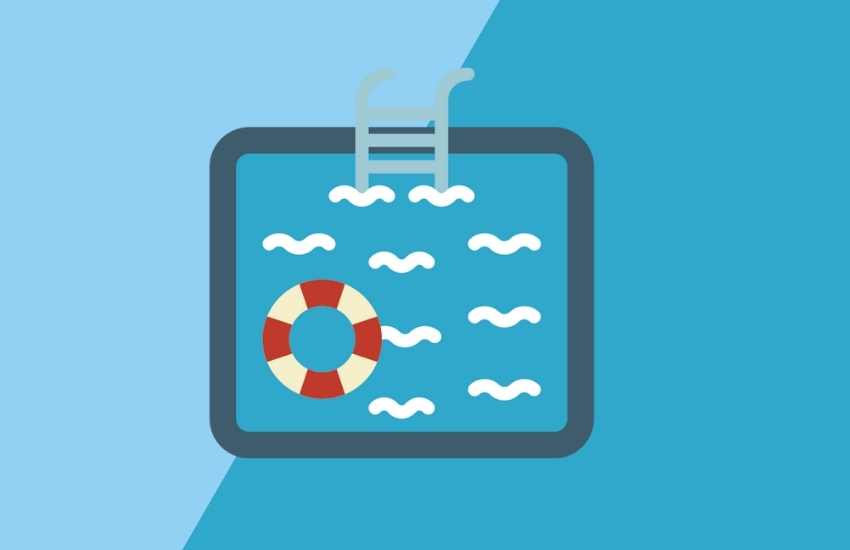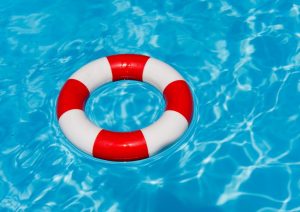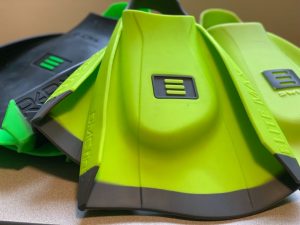
7 Best Swim Snorkels for Better Technique and Faster Swimming
Ready to throw down on a new swimmer’s snorkel? Here are reviews of the best swim snorkels for lap swimming.

Looking to open your above-ground pool for a season of sun and fun? Here is a simple 9-step process for opening your pool like a champ.
Opening the above-ground swimming pool is basically the unofficial kick-off to summer.
But if you’ve never done it before, it can be daunting.
Here’s a step-by-step guide on how to open your above-ground pool and make the most of your summer.
Let’s dive right in!
A simple way to save yourself more work later in the summer is to clear the area around your above-ground pool.
Leaves, twigs, dead insects—they can quickly tax your filter and pump and create more work than necessary to keep the pool clean over the summer.
Take this opportunity to nip that in the bud by doing some quick landscaping around the pool.
Next, it’s time to peel the lid, err, cover, off the pool.
Whether you used a regular pool cover or a sturdier winter pool cover, it’s time to see how the water has been doing since you closed the swimming pool at the end of the summer.
If you were proactive, you took time to regularly clear it of debris and water over the winter. If not, no worries—it’s time to clear it of months of leaves, debris and water.
Pooled-up water on the cover can be quickly dispensed with a quality pool cover pump.
While a little dirty water and debris sliding into the water aren’t catastrophic, fully clearing the cover before opening it will save you a little work and time later in the process.
Once removed, wash, dry and store your winter pool cover.
At this point, it’s time to take stock of how the pool held up over the winter.
Start by removing any expansion or freeze plugs from the inlets, skimmer intake, jets, and so on.
If you used a skimmer cover over the winter to keep water out of the skimmer, remove it.
Even though it was covered over the winter, evaporation is going to happen. Also, depending on how you closed the pool, you will have lost some water in that process.
Your pool is thirsty, so give her a drink.
Hook up the ole garden hose and start pumping water into the pool until it gets to the midpoint of the skimmer opening.
Depending on your municipality’s water quality, it might be worth using a filter on your hose to keep any unwelcome impurities from getting into the water and give you a step on balanced pool chemistry.
Okay, this one is going to be a multi-step step, depending on how much equipment you have and what condition they are in.
Time to grab and clean your:
Deck equipment. Pull out your above-ground pool ladder and above-ground pool accessories. Wipe them down, clean them off, dust ‘em.
Filter and pump. Plug in the filter and pump, bringing it back to life Frankenstein-style. Hook up the skimmer, chlorinator, and whatever other filtering equipment you have. Check connections.
Turn on the pump and filter and check to see that everything is functioning properly.
If you have a pool heater, make sure that everything is working optimally in terms of circuit breakers, switches, and so on.
Watch your pool equipment come back to life.
Next, we are going to tidy things up.
Even though winter covers are awesome at protecting the pool liner and walls of your pool, they don’t keep the pool water perfectly clean.
Especially if the water has been sitting and not was not properly circulated while closed.
Check the pool for any surprise guests like algae formations.
At this point it’s worth doing the scrub, vacuum and skim clean.
Clean your pool before dropping any opening pool chemicals into the water.
Pool owners (should!) know the importance of testing the pool water.
Whether you are using pool test strips or a digital tester, it’s time to take stock of your pool chemistry.
Do the requisite breath hold while waiting for the results.
From here, your actions will be guided by the results from your pool test kit.
Once you are feeling pretty good about the pool chemistry being in order, it’s time to unleash the pool shock.
How much shock you use depends on the size of your swimming pool and the type of shock you are using.
Do some brain math and run the numbers per your pool shock of choice and the size of your swimming pool.
While the sun is great for giving you a bitchin’ tan, it will also burn off unstabilized chlorine.
Apply your pool shock after the sun has gone down so that you don’t have to add more shock later to complete the process.
Once you’ve dropped the shock, give the pool time to fully circulate all the water.
Give it at least 24 hours before retesting. By then, your pool should—fingers crossed—be ready for sun and fun!
And finally, the most crucial step…
Kick back, crack a cold one, and call your family and friends.
It’s time to enjoy the living daylights out of your freshly clean and freshly opened above-ground pool.
6 Best Variable Speed Pumps for Swim Pools. Frustrated with big electricity bills from your backyard pool? Replace your standard pool pump with one of our favorite cost-saving variable speed pool pumps.
5 Reasons Your Pool Has Cloudy Water and How to Fix It. Frustrated with cloudy pool water? Here are five reasons it’s happening and proven fixes so that you can get back to enjoying your pool.
How to Drain an Above Ground Pool. Looking for information on how to drain an above ground pool? Follow the simple steps in this guide and do it right the first time.
How Hard is it to Maintain an Above-Ground Pool? Curious about what kind of work is involved in keeping your above-ground pool in tip-top shape? Here’s an overview of what’s what when it comes to a properly maintained pool.
Subscribe to the YourSwimLog.com newsletter and get tips and advice on how to swim faster every weekday morning, straight to your inbox.
Join 33,000+ swimmers, coaches, and swim parents learning what it takes to swim like a boss.
Unsubscribe anytime. Email will never be shared or sold.

Olivier Poirier-Leroy Olivier Poirier-Leroy is the founder of YourSwimLog.com. He is an author, former national level swimmer, two-time Olympic Trials qualifier, and swim coach.

Ready to throw down on a new swimmer’s snorkel? Here are reviews of the best swim snorkels for lap swimming.

Looking to get some new swim gear on a budget? Shop the best Black Friday deals for swimmers in this exclusive guide.

Looking for the best swimming app to maximize your time and effort in the water? Here’s a look at the top swim apps for conquering your swim workouts.

Wondering how often you should be testing the water in your pool or spa? Here’s a detailed look at how frequently you should test your pool. Your swimming pool and spa relies on being properly balanced to keep the water clean and safe for swimming. As a pool owner, you

Fed up with the effects and smell of chlorine in your hair after swimming? Here is how to remove chlorine from your hair once and for all.

The DMC Elite fins are high-performance training fins for competitive swimmers. Here’s a review of why these fins are flat-out awesome.

LANE 6 PUBLISHING © 2012-2024 · PRIVACY POLICY · RETURN POLICY · TERMS OF SERVICE · AFFILIATE DISCLOSURE